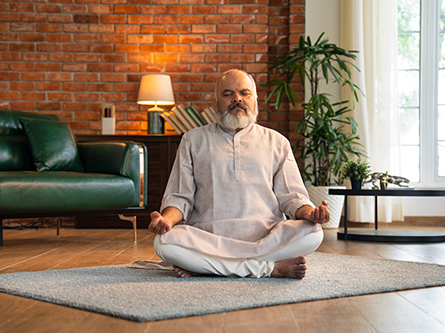
Millions of people across the world have some form of arthritis. Arthritis is inflammation in your joints that can lead to cartilage loss.
Arthritis in the shoulder can make it difficult to do simple tasks like brushing your hair or reaching above your head. There are some non-surgical treatments that can help relieve shoulder pain, in addition to shoulder surgery.
Our orthopaedic shoulder and elbow surgeon Mariano Menendez answers some of the top questions about shoulder arthritis, how to manage it and more.
What does an arthritic shoulder feel like?
An arthritic shoulder can feel stiff, sore, and weak. Pain is the most common symptom. It may start as a dull ache and get worse over time. Many people feel pain when they move their arm, especially when lifting or reaching. Others feel pain even when resting, especially at night.
The shoulder may also feel stiff, making it hard to move the arm fully. Some people hear or feel grinding, clicking, or popping when they move their shoulder. Weakness in the arm is also common, making it hard to do daily tasks like getting dressed or carrying things.
Learn more about joint arthritis of the shoulder
What causes shoulder arthritis?
Shoulder arthritis happens when the smooth cartilage in the joint wears down. Cartilage helps bones glide smoothly when moving the arm. When it wears away, bones rub against each other, causing pain and stiffness.
These are common reasons why this happens:
- Aging: Cartilage naturally wears down over time. This is called osteoarthritis.
- Past injuries: A broken bone, dislocation, or repeated injuries can damage the joint.
- Rheumatoid arthritis: This is an autoimmune disease where the body attacks its own joints, leading to swelling and pain.
- Overuse: Repetitive motions, like lifting heavy objects or playing certain sports, can wear out the joint faster.
- Genetics: Some people are more likely to get arthritis because of their family history.
See the six common types of arthritis and related conditions
What exercises should you avoid with shoulder arthritis?
If you have shoulder arthritis, some exercises can make pain and stiffness worse. It's best to avoid movements that put too much stress on the joint. Here are some exercises to be careful with:
- Heavy weightlifting: Lifting heavy weights, especially overhead, can strain the shoulder.
- Push-ups and bench presses: These put a lot of pressure on the shoulder joint.
- Repetitive overhead movements: Activities like throwing, swimming, or certain gym exercises can wear out the joint.
- Behind-the-neck presses or pull-downs: These force the shoulder into an awkward position and may cause pain.
Instead, focus on gentle exercises that improve flexibility and strength. These can include stretching, light resistance training, and low-impact activities.
Find out how you can improve your stretching and flexibility for better health
How do you treat shoulder arthritis?
There are many ways to treat shoulder arthritis, depending on how bad the symptoms are. The goal is to reduce pain and keep the shoulder moving as much as possible.
Non-surgical options
Most people start with simple treatments:
- Rest and activity changes: Avoid movements that make pain worse.
- Ice or heat: Ice helps with swelling, while heat can relax stiff muscles.
- Medications: Over-the-counter pain relievers like ibuprofen or acetaminophen can help.
- Physical therapy/exercises: Gentle exercises can keep the shoulder flexible and strong.
- Steroid injections: These can temporarily reduce pain and swelling.
Surgical options
If the pain is severe and other treatments don't help, surgery is an effective option, typically in the form of shoulder replacement. A shoulder replacement replaces a worn out joint with an artificial joint. This can very efficiently relieve pain and restore movement.
Learn about our world-class and personalized orthopaedic care
Explore our care for arthritis and rheumatology
Is shoulder replacement surgery the most effective way to treat shoulder arthritis?
Shoulder replacement surgery is the most effective treatment for severe arthritis when other options no longer help. It can greatly reduce pain and improve movement. However, surgery is usually the last resort after trying other treatments like medications, physical therapy and injections.
Shoulder replacement may be the best option when:
- Pain is constant, even at rest.
- The shoulder is very stiff and weak.
- Daily activities, like getting dressed or lifting objects, are too difficult.
- Shoulder pain wakes you up or keeps you up at night.
- Other treatments no longer work.
In general, most people feel significant pain relief after surgery. Many regain good movement in their shoulder and can return to daily activities. However, recovery takes time, and physical therapy is needed after surgery.
Learn if shoulder replacement surgery is right for you
How is shoulder arthritis diagnosed?
Shoulder arthritis is typically diagnosed during a physical exam by a specialist. Your health care provider will look for tenderness on the joint and pain with compression of the joint. X-rays may be used to see if there's a narrowing of the joint and any bone spurs around the joint.
Sign up for our Health Highlights e-newsletter
How can I see a UC Davis Health specialist to discuss treatment options for shoulder arthritis?
Your primary care provider can refer you to an orthopaedic shoulder surgeon at UC Davis Health. Once you schedule an appointment, our specialists can help diagnose and treat your shoulder arthritis.
Learn how to schedule an appointment and get a referral
This blog was written by orthopaedic shoulder surgeon Mariano Menendez. He specializes in treating patients with shoulder and elbow issues at the C Street Sports Medicine Clinic in Sacramento, as well as the Edwards Family Athletics Center in Davis, Calif.




